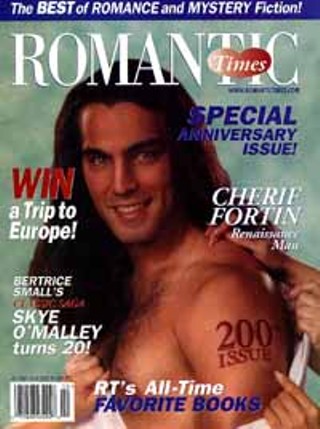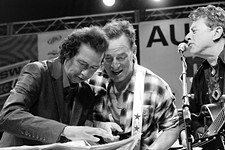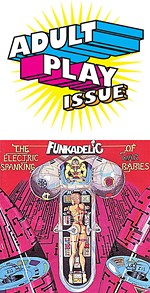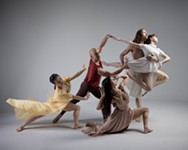New Writers of the Purple Prose
Looking for Love in All the Right Places
By Margaret Moser, Fri., Dec. 8, 2000

As the rest of the country began settling into Indecision 2000, about 1,000 women were looking for love in Houston, Texas. Romantic Times magazine's 18th annual Booklovers Convention opened on a cool, sunny Thursday two days after the presidential race, but at the Radisson by the Astrodome it was as if the election had never happened. Empire waists, velvet capes, laced bodices, floor-length gowns, and ornate jewelry abounded among these lovers of love inside the spacious, Western-themed hotel. It wasn't a mass audition for Camelot; it was England/Medieval Day, one of numerous dress-up and costume events designed to entertain conventiongoers. Romance conferences are about hopes and dreams for people in the business or pleasure of love-by-the-book.
The Romantic Times Booklovers Convention is to the romance genre what Nashville's yearly FanFair is to country music. It is a nonstop, meet-and-greet onslaught of authors, publishers, readers, cover models, editors, reviewers, publicists, agents, cover artists, booksellers, and just about anyone else who contributes to romance publishing, the industry that raked in $1.35 billion in 1999.
Consider that figure again. $1.35 billion in filthy lucre. Well, maybe not filthy, but the romance genre that generates that kind of money has definitely turned up the heat: Handsome, virile heroes are still in, but ripped bodices are out. Contemporary heroines are smart, witty, and resourceful. Everlasting love is the eternal theme, and the ending is always happy. That's what the readers want, all 41 million of them, and they buy 58% of the popular paperback fiction in America, according to the Romance Writers of America (RWA), an 8,200-member organization established in Houston in 1980 by 37 writers tired of getting ignored at traditional writers conferences. In such a lucrative and prolific field dominated by publishers elsewhere, it seems astonishing that the yin and yang of love in print are located deep in the heart of Texas.
Dreams of the Everyday Housewife
When it comes to reading, love everlasting never goes out of style. "People call it escape, but I don't think that's what it is," contends the petite, pixie-ish Falk, who has made a small empire out of that je ne sais quoi. "Romance books are important to the female psyche," she asserts. "Maybe not every woman, but being a booklover means being a book reader. I don't go anywhere without a book in my purse." Falk's 20-year-old fan-based publication celebrated its 200th issue in November, giving even more reason for celebration at the convention. When Falk bills it as the "Party of the Century," she's not kidding. November 9-12 is packed with theme days, costume parties, dinners, breakfasts, dances, charity events, gaming, book sales, vendors, celebrities, author and cover model meet-and-greets, and photo ops galore, and three days of 80 workshops on 12 tracks of the romance industry. The goody bag alone is loaded with a half-dozen paperbacks among the dozens of bookmarks, flyers, pens, calendars, and assorted geegaws like bath salts, a corkscrew, mousepad, and a mini-calculator. Just what is it about the notion of love in print that makes this all so vital?

Bobbi Smith is one of the more successful names with 30 books, six short story collections, and more than three million books in print since 1982, and she has one explanation for the appeal of romance novels. "Sometimes when I'm speaking, I'll read my Top 10 Reasons Why Romance Sells," the dark-haired, vivacious Smith says, and then ticks off the top three reasons. "3) It beats the heck out of watching your husband click channels from the recliner. 2) There's a guaranteed happy ending. 1) Women always win!" Smith, like so many other authors at the convention, was a wife and working mother when she decided to try her hand at romance though she has been writing "all [her] life." Her most recent novel in her series of romances set in the Old West includes an essay at the back written at age nine, "typos and all," with a note to teachers and parents that "if your child is writing like this, please encourage it!"
"We romance authors are not made, we're born," Smith decides. "We were the ones staring out of the window during math class," she jokes, but her sentiments are echoed throughout the convention. St. Louis-based Eileen Dreyer recalls the early Eighties when she and a friend were working as nurses at a local hospital. "We used to stand in the parking lot at 3am saying, 'There's got to be something better than this.'"
Dreyer has since written 21 books for Silhouette under the name Kathleen Korbel and six suspense and seven short stories as Eileen Dreyer. RWA's RITA Awards are the romantic equivalent of Oscars and they honor excellence in the genre, presented to the best published romances in 12 categories. After Smith won three RITA Awards, she was honored in the RWA Hall of Fame. "Something better than this," like the promise of a romance book, came true for Eileen Dreyer. Sharon Sala lives in Oklahoma and also writes for the Silhouette line. She concurs with Falk about being a fan and a reader. "Books were always my 'Calgon, take me away!' I was a huge reader before I ever started writing." Mundane as it sounds, the "Calgon moment" is a powerful metaphor for the appeal of reading romances. In that sense, escapism is paramount; the author must seduce the reader with words. All romance writers know the rules, from the most prolific bestsellers to first-time category romance hopefuls.
But as Sala points out, "There's an unwritten rule that no matter what we do to our characters, it has to end happily ever after. And that's what's so different in the real world. Romances don't always end happily, neither do lives. And it's so good, as a reader, to get to that part in the book where it comes together and ends like you want it to."

Once Upon a Time
For the most part, the 2,000-plus romance titles published this year raking in the bulk of that $1.35 billion will use one of seven basic categories: contemporary, historical, inspirational, paranormal, Regency/Victorian, romantic suspense, and time-travel. While the "inspirational" romances reflect Judeo-Christian themes and moral values with little or no sex, the rest of the subgenres depend on sexual tension between the heroine and the hero. (Some publishing lines are designed specifically for spicier reading.) These seven categories come in one of two formats. They are either "series" or "category" romances, meaning the books are released by number or order, and are short reads, such as those that Harlequin Books publish. Or they may be "single title" romances, generally published by one of the major New York publishers like Avon, St. Martin's, or Berkley.
Five traditional themes dominate most romance novels: marriage of convenience, secret baby, rags to riches, kidnapped, and the ever-popular amnesia victim. Variations on those themes include taming the beast/shrew, mistaken identity or masquerade, instant family, reunion, wrong side of the tracks, or the social fixture who falls for the social outcast. Executive senior editor Leslie Wainger has worked for many years with author Sharon Sala, among others. Her understanding of the enduring appeal of themes is as sensible as it is humorous. "Why do 'marriage of convenience' books sell so well?" she wonders. Because "none of us would ever get involved with one! Because the readers love it!"
Readers. Those 41 million people buying the more than 2,000 romance titles published this year. That is why Kathryn Falk makes sure that readers are as much a part of the festivities at the Romantic Times Booklovers Convention as are writers and industry people. The romance field is unique in its symbiosis: Most writers come from the ranks of readers and therefore understand the marriage of reader and book. The sisterhood and moral support in this almost exclusively female dominion is palpable. It is also gratifying and empowering and, in a few cases, exceedingly lucrative. Bobbi Smith is enthusiastic about the feminine camaraderie. "Ninety-eight percent of the romance writers are women," she points out. "Eighty percent of the editors are women. Fifty percent of the agents are women. Many of the sales reps are women. ... This is the industry for women!"
Author Elizabeth Grayson, who is also Eileen Dreyer's critique partner, sees a full-circle effect. "As romance authors, we nurture each other through those hard times. And I think women read romance novels to be nurtured, so we nurture our readers through the books we write. And that's why we write."
Dream Lovers
The presence of cover models is no small attraction for the fans in Houston. Here, in the flesh, are the heirs to Fabio: Ryan Storm, Leland Burbank, Mark Johnson, and David Alan Johnson. There are many others strutting around with barely tamed manes of hair, one looking as if he would rather pose for other men instead of the women, and another looking like he spent a tremendous amount of time in front of a mirror. They move and act the same way Playboy Playmates do during official appearances: remarkably attractive in person, friendly, posing for pictures, autographing photos with heartfelt thanks and love, and oh yes, kisses and hugs.

Cherif Fortin is among the cover models in attendance. Fortin is arguably the new Fabio, but he is less bulky and has a gentle demeanor that makes him even more striking. With long black hair and smoldering green eyes under well-shaped brows, he, too, fits the bill for the dark and handsome dream lover. His brooding good looks suit medieval knights, Native Americans, sheiks, and other dark warriors.
The coupling of the man and woman is called a "clinch" or "clutch" cover. They are very popular on some publishing lines and nonexistent with others. Some readers find the clutch covers embarrassing, hence the invention of what is termed the "element" cover, one with a benign arrangement of flowers, watches, clan tartans, or pendants that open to a secondary cover to show the couple in the throes of passion. Cover model David Alan Johnson was Romantic Times' first Mr. Romance in 1993. It's permissible to snicker or laugh here because no one will dispute the fluffy sound of the title, least of all Johnson. Neither will anyone deny that Johnson is just how the dream gunslinger hero or medieval rebel should look: taller than average, impossibly beautiful face, well muscled but not too beefy, dark-haired, green-eyed, and an utterly disarming smile. Johnson is also brimming with charm and a healthy dose of good humor about his professions.
"I'm 36. I had to be more than just a waiter with a dream of getting on a soap opera," he jokes. "Back in 1993, I was a USDA inspector for the poultry division. A friend urged me to enter the Mr. Romance Contest, and I did, but I didn't tell any of my friends or family. And I won. But since I was the first one, I was sort of a guinea pig. After that, I went to L.A. and got an agent and started doing the acting-modeling-commercial thing as well as still doing surveillance for USDA."
The idea of Mr. Romance grading eggs is almost enough to compromise the hero image. Almost. When singer Candye Kane is discovered to be a mutual friend, David Alan Johnson relaxes and leans forward, delighted to focus attention on something besides his looks. It is when he drops the affected but warm professional hunk smile that he becomes his most un-self-consciously, knee-knockingly, heart-stoppingly, drop-dead handsome. Johnson talks about playing drums as a form of meditation, and confesses to liking Limp Bizkit and Korn, though he seems much too courtly to ascribe to their misogynist politics. On the other hand, if you just happened to be a spirited Irish heiress forced by dire circumstance to marry a mysterious but dashing English duke who looked like Johnson, politics might well be damned. That's how potent a romance novel cover image can be. Bobbi Smith recalls a publicity tour she undertook with Johnson for Midnight. They traveled to Wal-Marts along the interstate to promote the book and were mobbed by women anxious to be photographed with a living, breathing cover model. "You could hear the squealing outside before the doors opened," she recalls. "It sold books but it sure wasn't me they were there to see!"

To clinch or not to clinch? Romance book reviewer Tina Early commented while Johnson described posing with a female model: "I don't like women in the cover. I like to see what the hero looks like," Early says. She is emphatic about her preference. What she says is crucial because it strikes at the heart of romance: The reader puts herself in place of the heroine. It's not the most politically correct sentiment but it is safe to say that romance readers all want to imagine themselves in the arms of Mr. Tall, Dark, and Handsome on the cover.
Black, White, and Read All Over
If David Alan Johnson is everything a hero should look like, Eboni Snoe is the picture-perfect romance author. She's young, eloquent, remarkably pretty, trim, and dresses in a wide-brimmed hat to die for. She's also a leading light in the rise of yet another subgenre for romance writers: Eboni Snoe is black.
Snoe floated into the conference wearing a suit Alexis Carrington would kill for. The Florida native speaks in honeyed tones that are as charming and alluring as her contemporary romance novels. "I created the name in 1990 and wanted people to know that from black to white to all cultures in between, I write for a universal audience. I have a deep commitment to that. Love has no color."
Snoe is one of the rising numbers of black authors in the romance field (see accompanying review of Evelyn Palfrey's title The Price of Passion). By the Nineties, the publishing industry saw the formation of many small presses devoted to romance subgenres. There are publishers, and authors, geared toward blacks, Hispanics, science fiction/fantasy themes, blatant erotic themes, lesbian, and even one specifically for overweight women. Multicultural romances are actively being developed, as Kensington Books editor Kate Duffy points to their Hispanic line, part of the Precious Gems series sold exclusively through Wal-Marts.
It's no secret that Seventies romance sensation "Jennifer Wilde" was really a Texan named Tom E. Huff, who died in 1990. In a kind of reverse-tribute to writers like Charlotte Brontë and George Sand who used men's names, the high school teacher-turned-romance author wrote 20 novels as Edwina Marlowe, Katherine St. Clair, and Beatrice Parker as well as three under his own name. His success has yet to be matched by a man in the field. Female co-authors are not uncommon, but rarest of all is the husband-and-wife writing team like Lori & Tony Karayianni, who write as "Tori Carrington." Like their peers, Lori and Tony love their work, and spout effusively about the various spicy titles they've written for several of Harlequin's sexier lines.
"I'm a man. I'm Greek. I'm not supposed to like this but I do. And who brings out a man's viewpoint better than a man? Plus, I get to work with her," Karayianni smiles winningly and hugs wife Lori. The biggest gender upheaval in the romance industry was much less analyzed or publicized. This year the Romance Writers of America elected Harold Lowrey president of their organization. For the first time in its history, the position is held by a man.
Happily Ever After
Aspiring authors dream of a publicist like Nancy Berland. She owns a PR agency in Oklahoma City and takes care of business like a New York pro. All of her clients are represented at the Booklover Convention's press table with colorful press kits and promo photos and only the cover models get better play. Berland even adopts a stray member of the press and sees she is not only taken care of with full honors but supplied with a nonstop stream of author and editor interviewees and reception invitations. A former newspaper writer herself, Berland was the chairman of RWA's 1995 National Conference public relations program and in 1999, she led an RWA workshop in Portland, Oregon, called "Divine Secrets of the PR Sisterhood." Her "secrets" seem to be very public. Berland is devoted to her client base of contemporary novelists like Debbie Macomber and Lisa Jackson, interracial romance author Dar Tomlinson, and Harvard Ph.D. Catherine Asaro. Her finesse is exceeded only by the recurring theme among all those here: These people love their work about love.
In the end -- and the endings are happy ones, remember -- what almost everyone in the romance industry would like is a little more R-E-S-P-E-C-T. Business issues aside, romance writers and readers are unique because in no other field is the "sisterhood is powerful" ethic so strong, not to mention how damn many books they sell. Romances are written to please that place in the heart where hope, especially when bolstered by love and imagination, springs eternal.
"And what in the world," editor Leslie Wainger wants to know, "is wrong with making people happy?" ![]()
Margaret Moser dreams of being a RITA Award-winning author of a historical romance featured on a Romantic Times cover with model David Alan Johnson.








